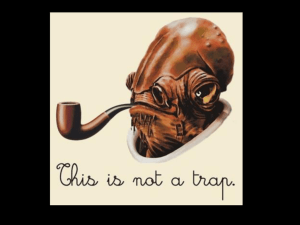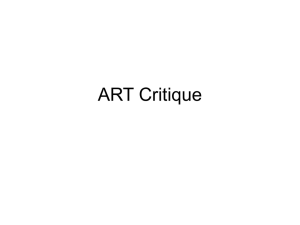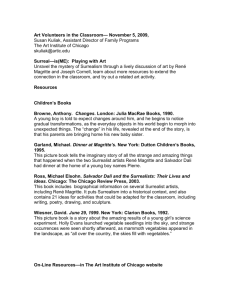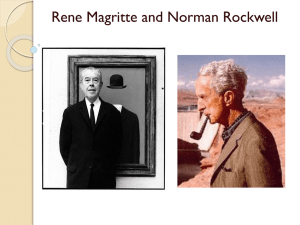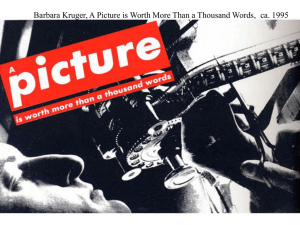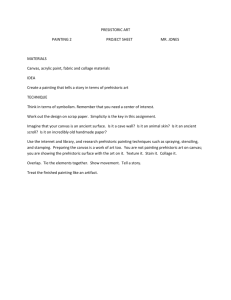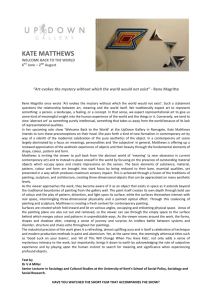objectives - Chrysos Designs
advertisement
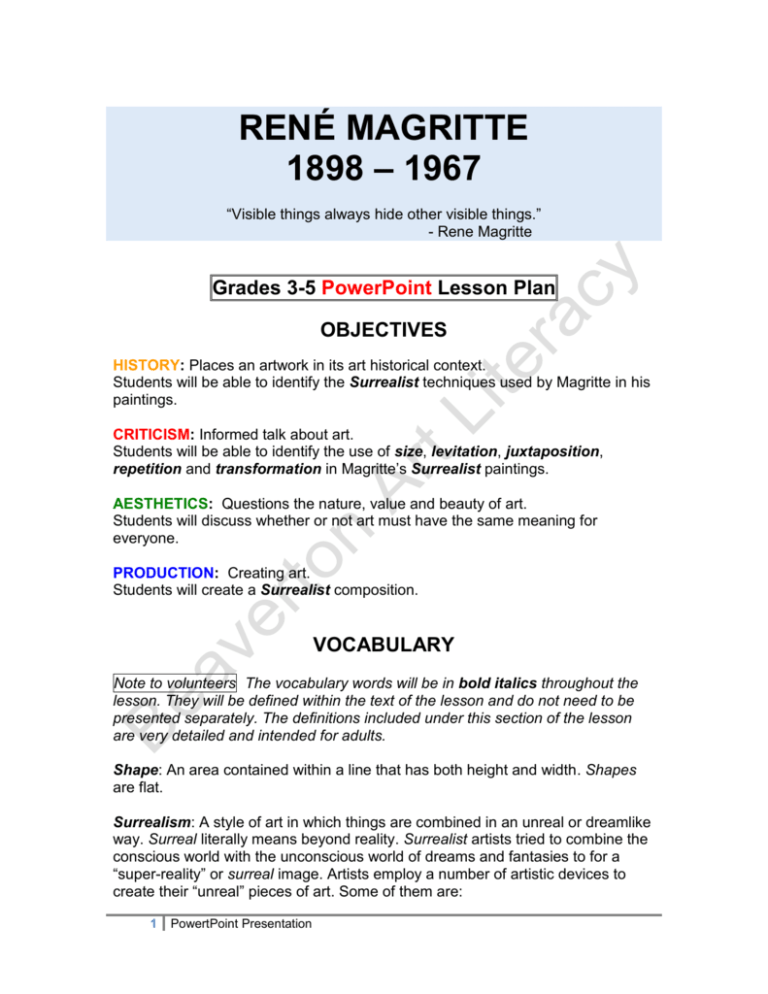
RENÉ MAGRITTE 1898 – 1967 “Visible things always hide other visible things.” - Rene Magritte Grades 3-5 PowerPoint Lesson Plan OBJECTIVES HISTORY: Places an artwork in its art historical context. Students will be able to identify the Surrealist techniques used by Magritte in his paintings. CRITICISM: Informed talk about art. Students will be able to identify the use of size, levitation, juxtaposition, repetition and transformation in Magritte’s Surrealist paintings. AESTHETICS: Questions the nature, value and beauty of art. Students will discuss whether or not art must have the same meaning for everyone. PRODUCTION: Creating art. Students will create a Surrealist composition. VOCABULARY Note to volunteers The vocabulary words will be in bold italics throughout the lesson. They will be defined within the text of the lesson and do not need to be presented separately. The definitions included under this section of the lesson are very detailed and intended for adults. Shape: An area contained within a line that has both height and width. Shapes are flat. Surrealism: A style of art in which things are combined in an unreal or dreamlike way. Surreal literally means beyond reality. Surrealist artists tried to combine the conscious world with the unconscious world of dreams and fantasies to for a “super-reality” or surreal image. Artists employ a number of artistic devices to create their “unreal” pieces of art. Some of them are: 1 PowertPoint Presentation size: object’s relative size is changed. levitation: objects rise or float in the air. transformation: objects turn into something else. repetition: objects or shapes are repeated. juxtaposition: placing inconsistent, incompatible objects side by side. symbols: objects represent an idea, thought or other object. Note to volunteers When describing these techniques to students it isn’t necessary for them to remember the specific words of juxtaposition, transformation, levitation, etc. They just need to be able to recognize the technique and be able to describe it in their own words. Note to volunteers When teaching primary grades (K-2), focus on only 2 or 3 of these techniques. INTRODUCTION Note to volunteers The pages shown under this section of the lesson are to get the attention of the students. Please do not stop and discuss these slides as they are viewed. Only use the text that is written. Much of the text for the INTRODUCTION is taken from “The Essential René Magritte” by Todd Alden. THE CASTLE OF THE PYRENEES 1959, OIL ON CANVAS, 79 x 55” Imagine this: You’ve just gotten off of the school bus one afternoon, and you are walking home. You notice the powder-blue sky dotted with puffy white clouds. Suddenly it feels like mignight, even though it’s only 3:00 PM, and when you look up, there, hanging above you – oh jeez – is a 20-ton boulder with a castle on top of it! TREASURE ISLAND 1942, OIL ON CANVAS, 23-1/2 X 31-1/2” You look down and the plants on the ground have turned to birds that fly away,… THE DISCOVERY OF FIRE 1934-35, OIL ON CANVAS, 13 X 16-1/4” ….while being accompanied by a band of flaming tubas. Let’s get out of here! THE TOMB OF THE WRESTLERS 1960, OIL ON CANVAS, 34 X 36” You race home, screaming for your mom…and there’s a giant rose in your living room. 2 PowertPoint Presentation RECOLLECTION OF TRAVELS III 1951, OIL ON CANVS, 80 X 64” You streak down the hall past the dining room that has turned to stone. PERSONAL VALUES 1952, OIL ON CANVAS, 80 X 100” You open the door to your room and this is what you see! What’s going on here? Welcome to the mysterious world of René Magritte. HISTORY THE SON OF MAN 1964, OIL ON CANVAS, 45-1/2 X 35” Even though there is an apple covering the man’s face, this painting is one of the only self-portraits that Magritte (Ma-greet) painted. Magritte was born about 100 years ago in a small European town in the country of Belgium. Magritte’s father was a businessman in the town and René was the oldest of the three boys in the family. He began painting classes in town at the age of twelve. As a young boy he also enjoyed writing detective stories and this fascination with mysteries would later play a part in his career as a painter. At the age of eighteen, Magritte entered an art school in Brussels. However, he became bored with the classes there and eventually quit school to begin a job painting posters. During this time, Magritte met and married his wife, Georgette, to whom he would remain married the rest of his life. Magritte continued to create posters and design wallpaper until things changed when he is twenty-six years old. A wealthy man who owned an art gallery said that he would buy anything that Magritte painted. From that moment on, Magritte became a full-time painter. LAVENDAR MIST BY JACKSON POLLOCK, 1950, OIL, ENAMEL AND ALUMINUM ON CANVAS, 7’4” X 9’11” Almost from the very beginning, Magritte looked at the world in a different way and he wanted to put his thoughts and views of the world in his paintings. He thought that the everyday world held hidden meanings and mysteries. While other artists were experimenting with paintings that weren’t realistic looking…. THE FALSE MIRROR 1928, OIL ON CANVAS, 9-1/2 X 12-1/2” ….Magritte painted objects and shapes that were familiar to everyone. His paintings were different, though, because he painted those familiar objects and shapes in unfamiliar ways. His paintings are done in a style called Surrealism. Surrealist artists tried to make people looking at their paintings think about their dreams or the mysteries (unknowns) of their world. The paintings were not supposed to have any concrete meanings behind them, but rather were supposed to lead to people thinking about things they normally wouldn’t when looking at them. 3 PowertPoint Presentation This is one of Magritte’s first paintings and it shows how he made familiar shapes and objects mysterious. While the painting is obviously an eye, Magritte has changed it by putting clouds in it. Magritte is known for taking everyday, familiar shapes and objects and using them in unfamiliar ways. Clouds and eyes are something we see all the time, but clouds are not part of an eye. THE LISTENING ROOM 1958, OIL ON CANVAS, 15 X 18” Magritte wanted people to experience the mysteries of life when looking at his paintings, to make them wake up and think in ways that they normally wouldn’t. To do this, he used a number of different techniques when he painted. What do you think is so strange about the apple in this painting? (It is far larger than normal, taking up the whole room.) Changing the size of a shape or object was a favorite Surrealist technique. The apple is very familiar to us but we are uncomfortable seeing it fill up an entire room. GOLCONDA 1953, OIL ON CANVAS, 32 X 39-1/2” This painting shows two more techniques that Magritte liked to use to create his mysterious paintings. What is so strange about the men in suits in this painting? (They are floating and they are all identical to one another.) Magritte painted the men floating (levitating) around, something that, of course, is impossible. The use of floating shapes and objects is definitely an unusual technique. Besides the floating technique, Magritte would sometimes paint the same shape or object over and over again. This technique is called repetition. In this case, he has repeated the floating man dozens of times. We’ve learned three Surrealist techniques that Magritte used. Can you name all three? (Floating objects (levitation) and shapes, repetition, and size.) THE RED MODEL 1935, OIL ON CANVAS, 28-1/4 X 19” This painting illustrates yet another Surrealist technique. In it, the pair of shoes are changed (transformed) into something else - a pair of feet! Both objects are used for walking around and one goes into the other, but here they are put together in a single shape. Surrealists liked to do this because the viewer becomes surprised at seeing the familiar shapes changed into such an unfamiliar object or shape. . 4 PowertPoint Presentation THE HEART OF THE MATTER 1928, OIL ON CANVAS, 46 X 31-1/2” This is, of course, a painting of a woman, a tuba and a suitcase. However, in this painting we are able to see once again how Magritte makes familiar objects and shapes seem strange and mysterious or unfamiliar. He does this primarily by using the technique of placing shapes and objects that don’t belong together next to one another (juxtaposition) or placing them in a scene where they don’t belong. He makes the painting even more mysterious by placing a hood over the woman’s head. Turn to your neighbor and see if you can list all five of the Surrealist techniques that Magritte used in his paintings. (Floating objects [levitation], juxtaposition, size, transformation and repetition.) CRITICISM TIME TRANSFIXED 1938, OIL ON CANVAS, 57-3/4 X 38-3/4” This is one of Magritte’s most famous paintings. In it we can see many of his Surrealist painting techniques. Sensory Properties: What do you see? 1. What Surrealist techniques did Magritte use to change the shapes in this painting? (Floating train, juxtaposition, and size of the train.) 2. What familiar shape or object is in the wrong place and is the wrong size so that this becomes a mysterious image? (The train.) Formal Properties: How is it arranged? 1. Close your eyes. When you open them, what is the first thing that you see? (The fireplace, because it is lighter than the rest of the painting.) 2. In art, painters often make a single part of the painting stand out or have emphasis so that the viewers know where to look. What do you think Magritte wants the viewer of the painting to look at if he has made the fireplace the focus of attention? (The train.) 3. Why does he do this? (It is the familiar object that makes the scene unfamiliar because the objects or shapes don’t belong together.) Technical Properties: What tools, media and techniques were used? 1. What materials do you think were used to make this painting? (Paint, brush, canvas.) Expressive Properties: What idea or mood does it express? 1. How does this painting make you feel? (Surprised, shocked, etc. answers will vary.) 5 PowertPoint Presentation AESTHETICS Note to volunteers These questions are meant to be open-ended; there is no right or wrong answer. SIGNATURE IN BLANK 1965, OIL ON CANVAS, 32 X 25” 1. Do you think that Magritte meant for every person looking at this painting to think the same thing or have the same feelings? 2. Do you think that art has to have a clear meaning or can it be a mystery like Magritte’s paintings? HISTORY (cont.) THE HUMAN CONDITION I 1934, OIL ON CANVAS, 39-3/8 X 31-7/8” What had Magritte done to make this painting seem mysterious or unfamiliar? (It is a painting within a painting. A painting placed on an easel blocks our view into the outdoor landscape. But is the landscape in the painting within the painting identical to the view from the window? What is real and what is just a “picture”? Once again, Magritte’s painting turns the familiar, unfamiliar and makes us change the way we understand objects and shapes. While many Surrealist painters lived very strange lives, and despite the interesting images that he painted, Magritte lived a very normal life. He lived most of his life in a small Belgian suburb and he painted neatly in the bedroom of his home. He lived for 69 years and almost all of those years very conventional, almost dull. His schedule was very regular. And yet, despite this, he was still able to make many mysterious paintings that people look at, and wonder at their meaning. PRODUCTION Criteria: 1. The artwork is drawn, cut, and pasted. 2. The artwork consists of realistic shapes and objects (windows, furnishings, etc.) 3. The artwork juxtaposes at least one set of objects or shapes that don’t belong together. Materials: 6 PowertPoint Presentation 1 9x12” piece of white 24 lb. paper per student 1 image of a landscape per student (use old magazines, article, etc.) 1 rectangle of light blue paper per student, all the same size as the landscape markers glue sticks scissors optional: magazines for additional images Instructions: 1. Once the landscape image has been chosen and cut out, cut a piece of light blue paper the same size as the landscape. 2. Glue the light blue paper onto the white paper. This is the window shape. The window can be high or wide depending on the image used. 3. Define the room (corner line on bottom, maybe a corner vertically visible) with markers. It would be help to have this step demonstrated on the blackboard by an adult volunteer. Another option would be to have the floor and wall lines preprinted on the white paper prior to the classroom presentation. 4. With markers draw the window frame, curtains, ruffles, etc. The window elements should not reach within the light blue area. 5. The room should contain at least one object, to show that the space is an interior space. Objects could be a lamp, small table, chair, plant, bookcase, etc. Have the students brainstorm small objects in a room before they start. Another option, if time allows, is cut furnishings for the room from magazine pictures. Besides placing a recognizable interior object in the room, students should also juxtapose the interior item with something that does not belong there. 6. Have the students cut “broken out pieces” from the landscape image. Point out to the students that it is better to have larger pieces cut out. Cut 3 to 5 pieces. Make the pieces jagged (not curved) to resemble broken glass. 7. Glue the landscape image (minus the cut out pieces) over the blue rectangle. 8. The pieces cut from the landscape image should be glued underneath the window. 9. Sign the artwork on the back. Michael Ball, 2005 7 PowertPoint Presentation

